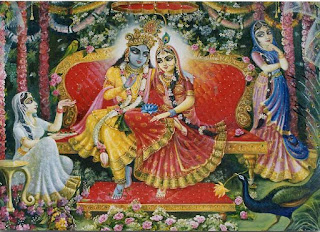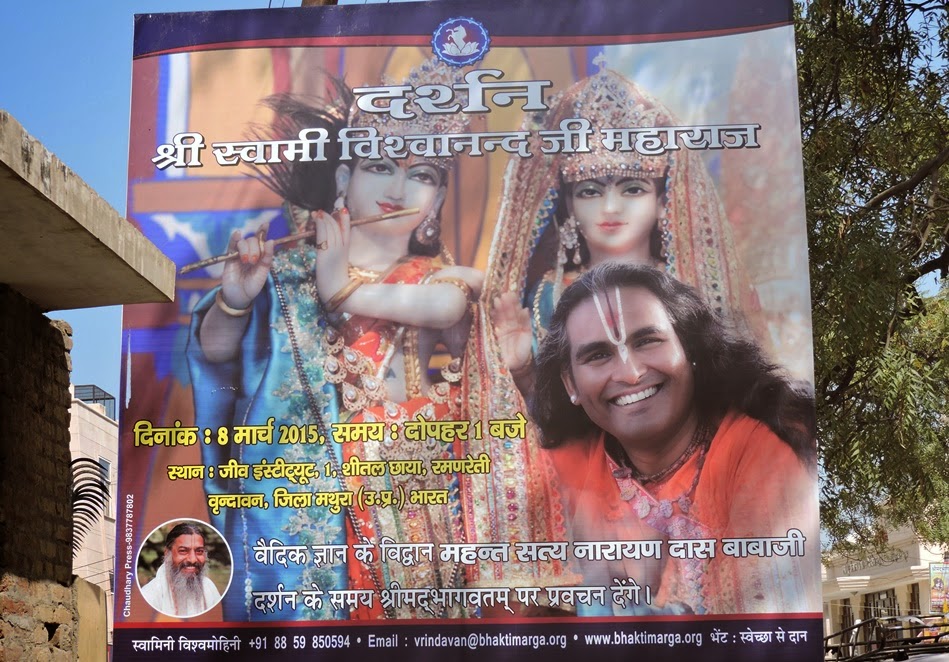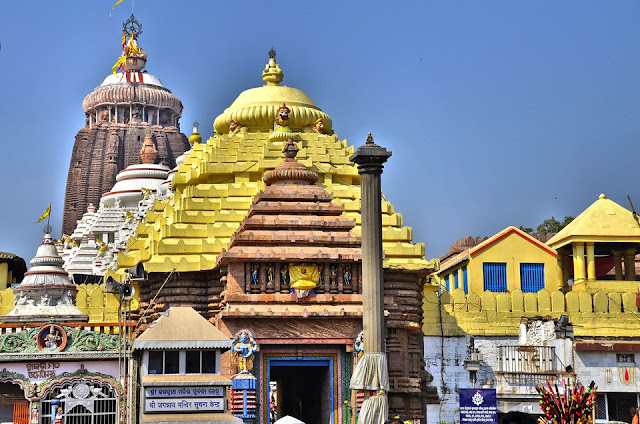Three Verses About Radha

With regard to Radha and Krishna as Rati and Smara (Kama):
Love (Rati) is Radha herself, the highest truth of all the material and spiritual worlds. So all the goddesses from Lakshmi on down, whose eyes are as beautiful as lotuses, all pray constantly for her merciful glance. Desire (Kama) is Krishna himself, the Supreme Lord beyond everything, who always takes satisfaction in his unlimited lovemaking, who [like the moon] causes the ocean of beauty [that is Radha] to overflow with just a single ray of his light. [Prabodhananda, VMA 11.46]What is interesting about this verse is that it makes Rati and Smara the subject and Radha and Krishna are the nominal predicates. In both cases, the word sākṣāt is used to indicate complete identity. I have often pointed to the Brahma-saṁhitā verse where the phrase smaratām upetya is found. "Govinda becomes Kama when his sac-cid-ānanda pastimes in the spiritual world are reflected in the world of matter. In this form he easily conquers the fourteen worlds." Here basically the same thing is being said, especially since both material and spiritual worlds are mentioned. Don't forget that Krishna is the Navina-madana, whose worship is conducted with the kāma-bīja and kāma-gāyatrī. I am sorry, folks, I did not make this stuff up.
This Hari when combined together with his own energy in lila, it should be understood that there is no difference between them, just like the two halves (cotyledons) of a mung dahl grain. He himself became (abhavat) separate (pṛthak) like a man and his bride, through manifesting two parts, both forms being equal. (Caitanya-candrodaya 4.43)That translation is a bit rough, but the idea of two in one is clearly expressed by the two parts of a mung dahl grain. The One became Two for the sake of lila as in the famous Bṛhad-āraṇyaka wording that seems to be the original basis for all of this thinking. The equality is not one of identity, but of equal parts of a single whole. The single whole, as indicated in the previous verse, is love; the two halves are Desire (Smara) and the Fulfilment of Desire (Rati).
I think that is clear enough. I have now put up many verses that state clearly that our iṣṭa is either (1) Krishna associated with Radha, or (2) Radha and Krishna together, which in my opinion comes to the same thing. They are inseparable. One without the other is meaningless. Neither represents the jiva. Both represent a different aspect of the One Truth as soon as it becomes differentiated in līlā.
Bhaktivinoda Thakur says, like Raghunath, that anyone who tries to worship Krishna alone, without Radha, is simply proud (abhimānī). The same applies to anyone who thinks they can worship Radha without Krishna. I include amongst such people those who try to prove the superiority of their own sampradaya by placing Radha above Krishna, even in sakhī-bhāva. Sakhī-snehādhikā does not mean that one worships Radha without Krishna. (This appears to be the mood in the Lalita-sampradaya, which is an offshoot of the Radha-vallabhis.)
Here is another great verses from RRSN (156) glorifying Radha's name.
Krishna discounts even an unlimited number of great offenses to the sadhus and being completely overwhelmed with love puzzles over what great gift he can bestow on the person who simply pronounces your immortal nectar-like name. O Sri Radhe, who then could ever reach the outer edges of the glory of those whose minds are entirely devoted to your service?Rādhā-dāsya means sakhī-bhāva, not nāyikā-bhāva. There is no hidden secret meaning here. That is Prabodhananda's intent. If anyone tries to draw some symbolic meaning out of this that was not his intent, then he or she is welcome to it. We believe in the revelation that came to those who revealed sakhī-bhāva.
When Rupa and others claim that mañjarī-bhāva is higher than nāyikā-bhāva, then we should at least do them the honor of trying to understand what they really mean. They have been fairly clear about it. The glory of Radha does not lie in her being a woman as such, but in her being the āśraya of love. This is a quality that is generally ascribed to women, but it does not end there, because Krishna is also the āśraya of love for Radha. Sometimes they do indeed reverse roles, as Vishwanath Chakravarti elaborately describes in the Kṛṣṇa-bhāvanāmṛta. But that is a part of the līlā and not meant to indicate anything more than the nature of love itself, wherein the pleasure of the āśraya is greater than that of the viṣaya. Nor does it change the fundamental or predominant roles of Radha and Krishna as āśraya and viṣaya.
As soon as you turn the āśraya into a viṣaya, you have missed the point. When we say that the jiva is a servant of the Divine Union, it means that she stays true to her eternal svarūpa of being an āśraya of love, but she does so by sharing in the very being of Srimati Radharani, the full manifestation of the Hladini Shakti, the embodiment of the highest love.
Men and women in this world, even those who are practicing sahaja-sādhanā, should think of themselves as participating in the being of Srimati Radharani, even though externally they may be engaged in playing the role of man or woman. The external role is simply a mise en scène. It is simply functioning as a trigger, like the deity form in the temple, to remembering, intuiting and actually feeling Radha and Krishna's līlā. Any pleasure they feel is recognized as prasāda and becomes a further spur to gratitude and love.
Anyone who masters this art will not only feel the love for his or her partner increase exponentially, but will also feel a sense of oneness with the līlā, a sense of joy and uplift at every aspect of Radha and Krishna's pastimes. They will see Radha and Krishna's pastime manifested in every nook and cranny of the material and spiritual universes. Thus the Gita's promise of the fulfilment of yoga will be kept. Yo māṁ paśyati sarvatra.
Moreover, they will win a victory over lust, just as promised in the Bhagavatam. Rather than waiting for a meaningless victory over lust by burning him like Shiva did. That is not a solution; trying to obliterate a problem is no solution. It is like the Americans in Vietnam, napalming villages only to see the Vietcong come out from the jungle in increasing numbers. The Hydra of lust simply grows ten new heads for every one you chop off.




Comments
Sexuality and Faith: For a Better Fulfillment
http://www.muslimwakeup.com/main/archives/2007/09/sexuality-and-f.php
"There's no point in being Irish unless you realize that sooner or later the world will break your heart." -- Daniel Patrick Moynihan
Even Radhika come to this realization eventually.
K's heart break also, to some degree, according to some kathayars.
But such kathayars said that R loves K thousands, millions of times more than K loves R.
So full Irishness is present in R, but not in K.
Such an imbalance led to the heartbreak factor. R was one-pointed to K, K not one-pointed to R, according to some kathayars.
These comments are quite correct, and yet they only state the problem and do not give the solution.
It is my feeling that everybody wants love and very few people find satisfaction, with the result that there is a general dissatisfaction with love and life itself. We are all settling for something less than what we want. There is little we can do about that because we are either fortunate or unfortunate.
For those who are unfortunate, they must work on becoming fortunate. True love ultimately comes to the worthy. No one finds love unless they become lovable. What are the qualities of the "lovable"? This is one thing, and it applies equally to this worldy love and love of God.
Where there is misfortune in worldly love, one must compensate through spiritual practice of one kind or another. There is really no other option. One can of course take shelter in mundane sense-gratification, but that is not very helpful.
Where there is good fortune, one must take it as a gift from God and act accordingly. In other words, a "gift from God" means more than just a mundane reward for good deeds, it means an opportunity to cultivate the true goal of life, a higher love, a transcendent and spiritual love that catapults one to the highest beatitude.
Someone criticized me once for creating such a great limitation on the practice of this sadhana: what about the child, the impotent, the aged and infirm? Are they all disqualified? Moreover, what about all the "lonely people"?
Of course, bhakti is open to all these people, and bhakti, especially madhura rasa bhakti is the baseline from which sahaja-sadhana is possible.
I have called this the pravartaka stage, following in the Sahajiya tradition. It means that one develops one's character and spiritual makeup in such a way that a particular kind of common culture is possible for sahaja-sadhana to take place. This is the preparatory stage and one cannot do without it.
And of course, as I said in the other post, experimentation and failure are a distinct possibility when talking of finding the right partner. This also is a part of the preparatory process. Actually, if both partners are sadhakas, then in theory at least, everything should be possible. But the rules of sat-sanga apply: the same goals, compatible personality and spontaneous loving attraction, and the ability to inspire spiritually are the three qualities of spiritual association. The middle one is the irrational, intuitive portion of the recipe. Unfortunate but true, but that irrational aspect is one of the true secrets to all spiritual life, because that is where the experience of grace is found. Without the experience of grace, the sense of the sacred loses its allure. This is the aspect that is in fact cultivated in sahaja-sadhana.
Do not lose faith. Chant the names of Radhe Shyam incessantly. Remember and contemplate the loves of Radha and Krishna. Krishna is a bee who eventually settles on one flower and remains enclosed in its petals never to escape the sweetness that is there.
I hope that helps somewhat.